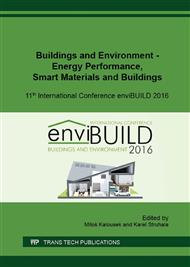p.361
p.369
p.376
p.384
p.392
p.401
p.409
p.417
p.425
Monitoring of a Prototypical Free-Running Building: A Case Study in a Hot-and-Humid Climate
Abstract:
The provision of comfortable indoor conditions is widely considered as one of the key tasks of architecture. Hereby, different climatic regions require different concepts for the operation of buildings. Achieving thermal comfort in buildings in hot and humid regions without Air-Conditioning can be considered as a challenging task. In this context we present a monitoring study of the indoor conditions in a new prototype building, called the Zero Carbon Resort Demonstration Cottage. This building was designed according to passive cooling principles with the intent to reach a high degree of sustainability and to have little environmental impact. To explore the viability of this concept, we deployed a comprehensive monitoring of the outdoor conditions via a weather station and of the indoor conditions via air temperature and relative humidity sensors. Moreover, short-term monitoring of thermal comfort was conducted. In a first analysis step we compared the results of the indoor monitoring with the corresponding outdoor measurements. In a second step we conducted a standardized thermal comfort study. Thereby we considered the special circumstances of the thermal comfort in naturally ventilated buildings. Results suggest that acceptable indoor conditions can be maintained, if passive cooling methods are applied properly.
Info:
Periodical:
Pages:
392-400
Citation:
Online since:
December 2016
Authors:
Price:
Сopyright:
© 2017 Trans Tech Publications Ltd. All Rights Reserved
Share:
Citation:



